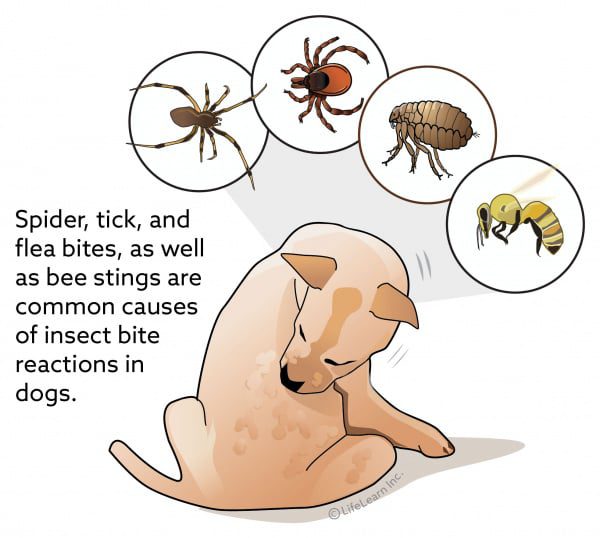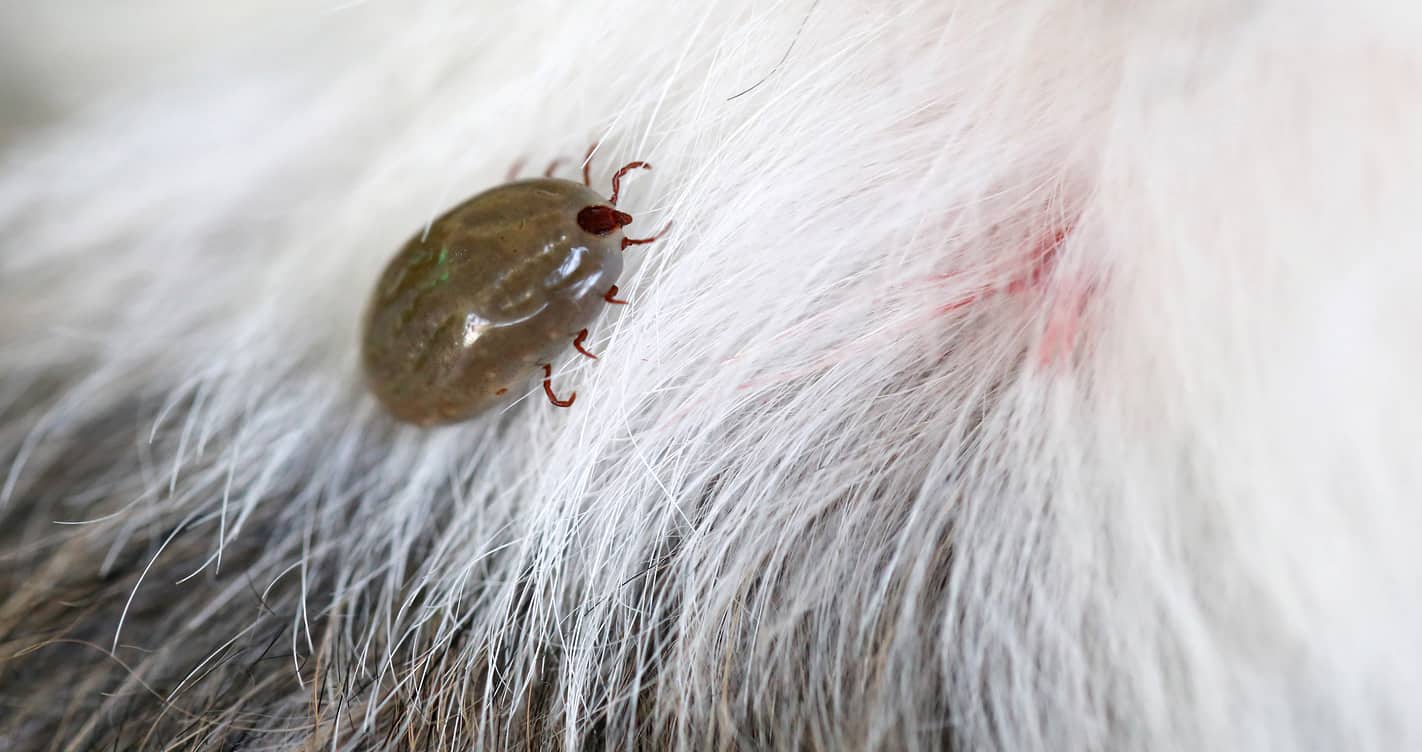
Dogs and insect bites
Small insects can cause a lot of trouble for a dog – from mild itching to serious illness. This guide will help you figure out what to do if you find insects on your dog or find bites, how to handle and prevent dog bites from some common insects.
Contents
Signs of fleas in dogs
What to look for: if a dog has fleas, it will constantly itch and lick. Look for fleas or black crumbs on the animal’s head, neck, and groin. Dogs with sensitive skin can suffer from allergic dermatitis, an allergic reaction to proteins in flea saliva. Fleas are also carriers of tapeworms, which can be passed on to your pet.
Prevention flea control in dogs is very effective. Ask your veterinarian about how to find an effective remedy in the form of a chewable treat, tablets, drops on the withers, or a flea collar.
How to get rid of fleas on a dog: to solve the problem, it is necessary to conduct a course of treatment. If you have not been able to prevent infection with these parasites, bathe your dog with a special flea shampoo. Vacuum and clean the areas of the house where the pet spends a lot of time, and if necessary, consider using flea spray or pest control in the house. Flea prevention and collars are always the best way to get rid of these insects! Once these bloodsuckers have entered a home, they are extremely difficult to eradicate.

Ticks in dogs
What to look for: ticks can live in almost any area and are found at any time of the year, but most often they wait for their victims in the grass and bushes from spring to late autumn, and in some regions – all year round. Look for small brown spots, swollen black or gray dots on the dog’s face, head, paws, flanks, limbs, ears and groin. It is necessary to inspect the animal after each walk or exit to the street. Even if a tick has landed on a dog’s body, such inspections will help prevent a bite or prevent it from moving onto other pets or even family members.
Ticks are carriers of serious diseases that can be transmitted to both animals and humans. Symptoms of conditions such as piroplasmosis (babesiosis), Lyme disease, ehrlichiosis, bartonellosis, can be difficult to diagnose and may not appear for days, weeks, or even months after a tick bite, according to the American Kennel Club Canine Health Foundation. Prevention is the key to keeping your dog healthy.
Prevention of ticks in dogs: Many drugs prescribed to prevent fleas also protect against ticks. To prevent tick-borne infections, check your pet from nose to tail after every walk and report any unusual behaviors, such as irritability or extreme lethargy, to your veterinarian.
How to get rid of ticks in a dog: if the pet is bitten by a tick, take tweezers or a special tool to remove the tick (these are usually available in veterinary pharmacies). Grab the tick as close to the dog’s skin as possible and gently pull while twisting it 2-3 turns if you are using tweezers without squeezing the body (this way you can crush the tick). Place the tick on a piece of tape or in a small jar of alcohol in case your veterinarian needs to test for disease. If you are not sure or the tick is not completely removed, it is better to seek help from a veterinarian.
Scabies mite in dogs
What to look for: scabies mites are so small and burrow so deep into a dog’s skin that they are hard to see. But any owner will notice the consequences – inflammation, hair loss and skin lesions. Scabies mites in dogs are noticeable by one symptom – severe itching. If your normally calm dog starts scratching and biting itself, it’s time to call your veterinarian.
Prevention: Unfortunately, there are no preventive measures against infection with scabies mites. These parasites are contagious and are transmitted through contact with other dogs and animals such as foxes. You need to watch if the dog began to itch after visiting a kennel or exploring places where wild animals can live.
How to get rid of scabies mites in dogs: The Woodruff Veterinary Clinic states that the most effective treatment is to see a veterinarian who, after an examination and appropriate research, will make an accurate diagnosis and tell you how to treat your dog.
What to do if your dog is bitten by mosquitoes
What to look for: Pets, like people, instantly feel the tingle at the site of a mosquito bite, so you can see how the dog suddenly licks, bites, or itches. A mosquito bite can cause swelling, redness, and hives in a dog, but it is unlikely to cause long-term harm on its own.
The most common problem associated with a mosquito bite on a dog is an infection with a heartworm – dirofilariasis. If the mosquito is a carrier of heartworm larvae (Dirofilaria), this dangerous disease can be transmitted to the pet.
Prevention: it is much more important to protect a pet from dirofilaria than from the bite itself. Give your dog the exact dosage of a veterinarian-prescribed oral or topical prophylaxis year-round, especially during mosquito season, advises the University of Illinois College of Veterinary Medicine. Special drugs to prevent heartworm disease can protect a dog’s heart and lungs and possibly save her life.
How to treat mosquito bites: apart from the risk of heartworm, the itchy bite is unlikely to cause long-term harm to the dog. There are natural and pet-friendly mosquito repellents. Ask your veterinarian what safe products they can recommend because some of them can be toxic to pets.

What to do if a dog is bitten by a bee, wasp or hornet
What to look for: accidentally stumbling upon an angry bee, wasp or hornet will be just as unpleasant for the dog as it is for you. The bite will cause sharp and intense pain, so you will probably hear the dog squeal. The dog will limp if he stepped on a bee, or scratch and lick himself if he was bitten elsewhere.
Some dogs are allergic to bee stings. In these cases, symptoms may include swelling, redness, hives, vomiting, diarrhea, incoordination, or even collapse. Even if the dog is not allergic, biting on the nose or mouth can make breathing difficult due to swelling. Call your veterinarian immediately if your dog has received more than one or two bee stings.
Prevention: bees are hard to hide from, but if there is a hive near your home that is bothering you and your dog, talk to a local beekeeper or exterminator about moving it.
How to treat bee stings: Dr. Patty Hooley writes in the Miami Herald that if a dog has been stung in areas other than the mouth or muzzle, an ice pack may be sufficient. Treat bee stings in dogs the same way you would your own, but never give your dog human medicines without first talking to your veterinarian.
Although insect bites are unavoidable in the summer, they can cause problems for you and your dog. By tracking the bites of the most commonly seen dog bugs, you can nip in the bud problems your furry friend may have.





